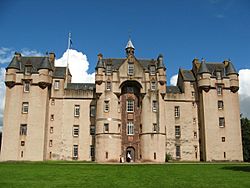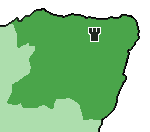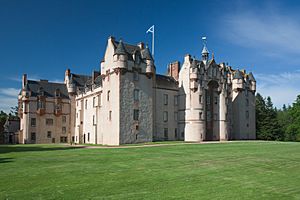Fyvie Castle facts for kids
Quick facts for kids Fyvie Castle |
|
|---|---|
| Near Turriff in Aberdeenshire | |
 |
|
| Coordinates | 57°26′36″N 2°23′42″W / 57.4433°N 2.3949°W |
| Site information | |
| Site history | |
| In use | 13th Century |
Fyvie Castle is a famous castle located in the village of Fyvie, close to Turriff in Aberdeenshire, Scotland. It is a very old and impressive building with a long history.
Contents
Exploring Fyvie Castle's Past
How Old Is Fyvie Castle?
The oldest parts of Fyvie Castle were built a very long time ago, in the 13th century. Some people even say it was built in 1211 by a king named William the Lion. Imagine, that's over 800 years ago!
Famous Visitors and Owners
Many important people have visited or lived at Fyvie Castle. Robert the Bruce, a famous Scottish king, once held a court meeting there outdoors. Later, King Charles I lived at the castle for four years when he was a child.
After a big battle called the Battle of Otterburn in 1388, Fyvie Castle stopped being a royal castle. Instead, it was owned by five different powerful families over many years. These families were the Preston, Meldrum, Seton, Gordon, and Forbes-Leith families. Each family added a new tower to the castle, making it bigger and more grand.
The Castle's Towers
The Preston Tower is the oldest part you can see today, built between 1390 and 1433. The Seton Tower is very grand and forms the main entrance. It was built in 1599 by Alexander Seton, who also added the amazing wheel staircase inside. The Gordon Tower was added in 1777, and the Leith Tower in 1890.
Inside the Castle Walls
Inside Fyvie Castle, you can see a huge wheel staircase. There are also displays of old weapons and armor. The castle has a collection of beautiful paintings by famous artists like Henry Raeburn and Thomas Gainsborough.
Battles and Important Stays
A small but important battle took place at Fyvie Castle on October 28, 1644. Manus O'Cahan and Montrose fought against the Covenant Army and won. This battlefield is now recognized as a historic site in Scotland.
Later, from 1650 to 1652, a woman named Anne Halkett stayed at the castle. She helped wounded soldiers and people who were sick in the area. She also talked with English soldiers who were there at the time.
Gardens and Modern Times
In the 1700s, the castle grounds and the nearby Fyvie Lake were beautifully designed.
In 1885, a rich Scottish businessman named Alexander Leith bought the castle. His family owned it until 1984, when they sold it to the National Trust for Scotland. This organization helps protect important places in Scotland.
Today, there is a walled garden to the east of the castle where Scottish fruits are grown. There were also other gardens closer to the castle in the past.
Mysterious Stories of Fyvie Castle
The Skeleton in the Wall
Like many old castles in Scotland, Fyvie Castle has some spooky stories! One tale says that in 1920, during some repair work, the skeleton of a woman was found hidden behind a bedroom wall. When the skeleton was buried in the local cemetery, strange noises and unexplained things started happening in the castle. The owner of the castle thought he had upset the dead woman. So, he had the skeleton dug up and put back behind the bedroom wall. After that, the strange happenings stopped!
The Secret Room and Curses
People also say there is a secret room in the castle's southwest corner. It is believed that this room must always stay sealed, or anyone who enters it will face bad luck. It's not clear if this is the same room where the skeleton was found.
Fyvie Castle is also said to have an old blood stain that can't be removed, two ghosts, and two curses!
One curse is linked to a wise man named Thomas the Rhymer. This curse involves three "weeping stones" that were taken from the castle's boundary. The curse says that until all three stones are brought back together, the first sons of the families living at Fyvie will never inherit the castle. Only one weeping stone is known to exist and is kept at the castle. The other two have never been found; one is thought to be built into the castle walls, and the other is believed to be deep in the River Ythan.
The second curse is about another hidden room, called the charter room. This curse is very specific: if anyone disturbs it, the lord of the castle will die, and his wife will become blind.
Fyvie Castle in Media and Events
On Television
Fyvie Castle has been shown on British television many times. It appeared in the "Most Haunted" series and STV's "Castles of Scotland." The castle was also the setting for a children's game show on CBBC called "Spook Squad" in 2004. It was also featured in the BBC documentary "Castle Ghosts of Scotland."
Books and Music
In 2009, a children's fantasy novel called The Time-Tailor and the Fyvie Castle Witch Trials by Deborah Leslie was published, which features the castle.
In recent years, the castle grounds have hosted a music festival called Fyvie Live during the summer. Famous singers like Beverley Knight, Sophie Ellis-Bextor, and bands like The Shires and Ward Thomas have performed there. In August 2024, the castle also hosted a re-enactment of the 1644 Battle of Fyvie, with people from all over the country dressing up in historical costumes.
Visiting Fyvie Castle Today
Today, Fyvie Castle is open for visitors between April and October. It is also a popular place for weddings.




